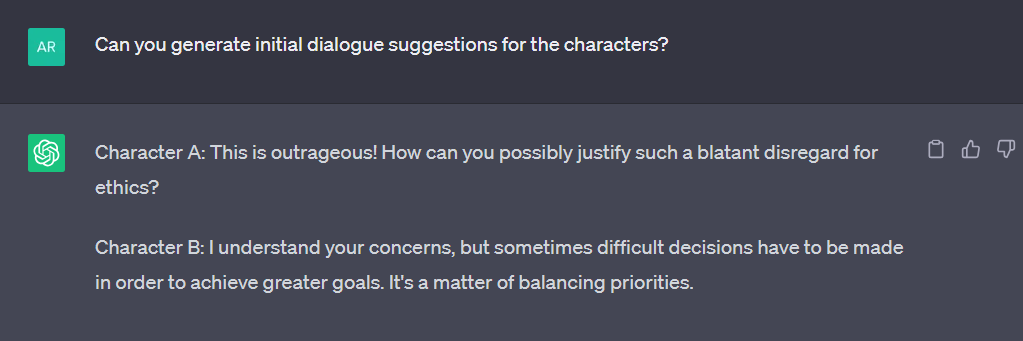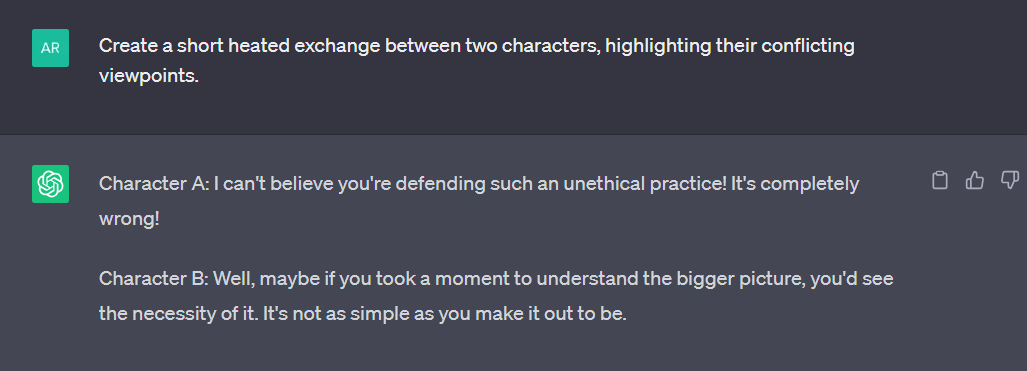How to Write a Book with ChatGPTIntroduction"The story of a book and its characters are a reflection of the imagination of a writer." When the story will turn in which direction, which character starts flowing against the current, it all depends on the writer's imagination. But the biggest question that arises here is whether Artificial Intelligence can think like a writer. With the advancement of artificial intelligence, is it possible that ChatGPT can write a story full of ups and downs, and can it think of a multi-dimensional role of a character? The answer to this is 'yes' and also 'no'. If seen, ChatGPT is capable of doing many things and can generate text like humans, but it needs more creativity and imagination like a human. ChatGPT can play a role of a partner for an aspiring writer. It can help the writer write a good story, create compelling characters, and create ideal plotlines and dialogues. In this article, we'll explore everything we need to know about how ChatGPT can assist a writer (us) in writing a book. We will explore the steps involved in using ChatGPT to write a book, including writing descriptions and story dialogues, and discuss the capabilities and limitations of AI in book writing. Let us start by answering the very first question. Can ChatGPT write a Book?Although ChatGPT can assist us and generate human-like text, it is still no substitute for human imagination and creativity. ChatGPT can generate ideas, suggest plotlines, and provide assistance with various aspects of writing, but the ultimate responsibility of shaping the book lies with the human author. With the help of ChatGPT, we can easily generate ideas, correct our grammar, enhance character dialogue, and improve our writing skills. Steps Involved in Writing a Book Using ChatGPT:
For example, if we're writing a fantasy novel targeting young adults, we would like to establish the magical elements, coming-of-age themes, and engaging storytelling style. 1. Getting Familiar with the capabilities and limitations of ChatGPTWe must understand AI's strengths in generating ideas, refining concepts, and providing insights while acknowledging its limitations in originality and understanding context. We can ask questions to ChatGPT like:
We can freely ask any additional questions related to preparing for the writing process, and ChatGPT will provide further guidance and insights on those particular questions. 2. Developing the Books Outlinea. Starting by brainstorming ideas for our book's plot, characters, and settings We can generate initial ideas for the main conflict, character motivations, and the world in which our story takes place. b) Collaborating with ChatGPT to refine our ideas, seek inspiration, and fill in knowledge gaps. We can engage in a conversation with ChatGPT, asking questions like: "What are some unique twists I can incorporate into my plot?" or "Tell me more about the historical context of this setting." Here are some questions we can ask ChatGPT on Developing the Book's Outline:
3. Writing the Descriptiona. Starting with a clear and concise summary that captures the essence of your book We can craft an attractive blurb that introduces the main conflict or mystery of our story and encourages readers to continue reading further. b. Using ChatGPT to help us craft engaging and compelling descriptions of characters, locations, and key events. For example, if we are introducing a main character, we might provide ChatGPT with important characteristics and ask it to generate an initial description. Then, we can make it better by including particulars that stimulate feelings and bring up appealing mental images. c. Experimenting with different writing styles and voices to find the one that best suits our book. ChatGPT can assist us in exploring different narrative voices, from a lyrical prose style to a rough, conversational tone. Here are some questions we can ask ChatGPT on Writing the Description:
4. Writing Story Dialoguesa. Outlining the main conversations and interactions between characters: We can determine the purpose of the dialogue, whether it's revealing information, developing relationships, or advancing the plot. b. Using ChatGPT to generate initial dialogue suggestions: To get dialogue suggestions, we must provide ChatGPT with the context of the scene and ask it to generate dialogue lines that align with the characters' personalities and intentions. c. Refining and editing the dialogue, ensuring it aligns with the personalities and motivations of our characters: Then we can polish the generated dialogue by adding specifics, unique speech patterns, and individual quirks to each character, making the conversations genuine and engaging. d. Incorporating feedback from readers or other writers to enhance the authenticity and impact of the dialogues: We can share the dialogue with beta readers or writing communities to receive feedback on its effectiveness, clarity, and resonance. It is one of the crucial steps. Feedback will help us improve the dialogues, plotlines, and twists. Here are some questions we can ask ChatGPT on Writing Story Dialogues:

5. Iterative Writing and Editing: Until We Get What We Wanta. Writing the first draft of our book, incorporating ChatGPT-generated content as needed: We can utilize the collaborative process with ChatGPT to create new scenes, develop subplots, or overcome writer's block. b. Reviewing and revising the draft, focusing on plot development, pacing, character arcs, and overall coherence: We must analyze the generated content critically, ensuring it aligns with the overall vision of our book and enhances its quality. Here are some questions we can ask ChatGPT on Iterative Writing and Editing:
Writing a book using ChatGPT is an iterative process. We can edit and rewrite the ChatGPT-generated content that best suits our unique requirements. We can continuously ask for suggestions and improvements to ChatGPT "until we get what we want". How to Write Story Dialogues with ChatGPT?A character's dialogue plays a crucial role in writing a book and holds significant importance for several reasons. Engaging and authentic dialogues can bring our characters to life. Here is how we can leverage the capabilities of ChatGPT in Writing Compelling Characters: 1. Outlining the purpose and tone of the dialogue: We must determine whether the dialogue aims to convey conflict, reveal information, showcase character dynamics, or evoke a specific emotional response. 2. Initiating a conversation with ChatGPT, providing the context and desired outcomes: For example, if two characters are arguing about a betrayal, we can describe the characters, their relationship, and the key points of disagreement. 3. Asking ChatGPT to generate initial dialogue lines. We can prompt ChatGPT with a request such as: "Create a heated exchange between Character A and Character B, highlighting their conflicting viewpoints." 
4. Editing the generated dialogue, ensuring it reflects the individuality and goals of each character: We can review the generated lines, launching them with distinct speech patterns, vocabulary, and motivations that align with each character's personality and objectives. 5. Considering the pacing, rhythm, and overall flow of the dialogue: We must analyze the generated dialogue for natural conversational flow, ensuring it captures the dynamics and tension between characters without becoming monotonous or lengthy. 6. Testing the dialogue with beta readers or reading it aloud to evaluate its effectiveness: We can share the dialogue with beta readers or read it aloud to assess its impact, realism, and emotional resonance. Beta readers can provide feedback on the dialogues that can be used for improving the dialogue. 7. Revising and refining the dialogue based on feedback received: We must incorporate feedback from readers or fellow writers to enhance the authenticity, clarity, and impact of the dialogues, making them more engaging and memorable. Here are some example questions we can ask on Writing Story Dialogues with ChatGPT:

ChatGPT can assist us in creating dialogue using these prompts that are appropriate for the situation and accurately capture our characters' personalities and feelings. Once the dialogue has been created, we can edit it to suit our unique requirements and the general tone of our story. How to Write a Compelling and Unique Scene with ChatGPT?ChatGPT can help us write a scene that is both attractive and unique, and this can be an exciting and creative process. Here is how ChatGPT can Help us in Creating a Scene: 1.Setting the scene: We can start by establishing the location, atmosphere, and mood of the scene. Then we will describe the sensory details to drench the reader in the setting. 2. Determining the scene's purpose: We must clarify what we aim to accomplish in the scene-whether it's advancing the plot, developing characters, revealing important information, or creating tension. This clarity will guide our interaction with ChatGPT. 3. Collaborating with ChatGPT: We can engage in a conversation with ChatGPT, providing the necessary context for the scene and asking for suggestions or ideas. For example, we can ask ChatGPT to generate dialogue lines, describe character actions, or propose plot twists. 4. Evaluating and Refining: We then review the suggestions provided by ChatGPT and select the plots that align with our vision for the scene. We can even consider incorporating unique or unexpected ideas to make it stand out. We will then polish and refine the generated content to match the tone and style of our writing. 5. Adding Depth and Emotion: We must focus on the characters' emotions, thoughts, and motivations to make the scene compelling. To do so, we can explore their inner conflicts, desires, and reactions. The next step is to Infuse the scene with sensory details, subtext, and vivid language to engage the reader on multiple levels. 6. Incorporating Conflicts and Tension: We can introduce obstacles, conflicts, or dilemmas to create suspense and captivate the reader's attention. We can use ChatGPT to explore different ways of intensifying the tension or resolving the conflict. 7. Editing and Revising: Once we are done with incorporating ChatGPT-generated content, we must review the scene as a whole. Also, ensuring coherence, consistency, and smooth flow. We can trim any unnecessary elements and refine the pacing to maintain the reader's interest. 8. Seeking Feedback: We can share the scene with beta readers or writing communities to gather feedback on its effectiveness, impact, and uniqueness. We will then consider their insights and suggestions to further enhance the scene and overall story. While ChatGPT can provide valuable suggestions, it's important to maintain our authorial voice and vision throughout the process. We can only use ChatGPT as a tool to inspire, refine, and enhance our writing, ensuring that the final scene reflects our creativity and storytelling skills. CONCLUSION:In conclusion, while ChatGPT can be a valuable tool for aspiring writers (us), it is important to recognize its limitations and understand that it is not a substitute for human imagination and creativity.
In all stages of writing, it is important to maintain our authorial voice and vision, using ChatGPT as a tool to inspire and refine our ideas. Remember, ChatGPT is a partner and assistant, but the creative power and responsibility for crafting an engaging and unique book ultimately lie with writer (us).
Next TopicWho created ChatGPT
|
 For Videos Join Our Youtube Channel: Join Now
For Videos Join Our Youtube Channel: Join Now
Feedback
- Send your Feedback to [email protected]
Help Others, Please Share









